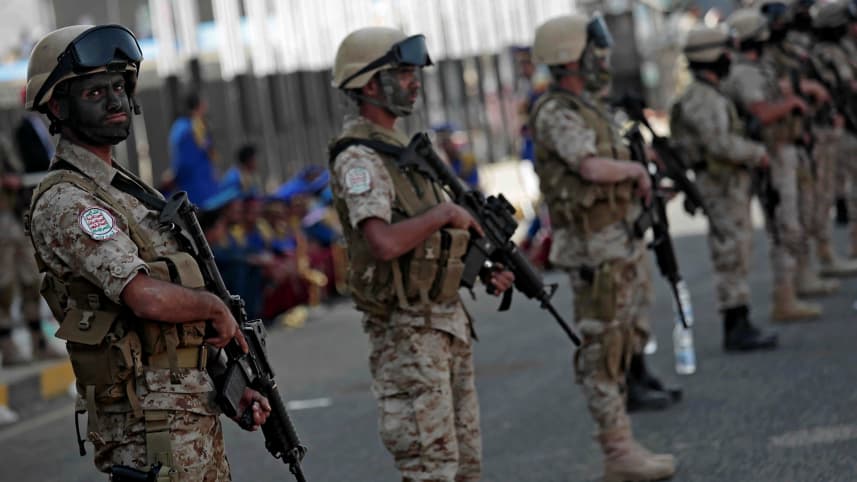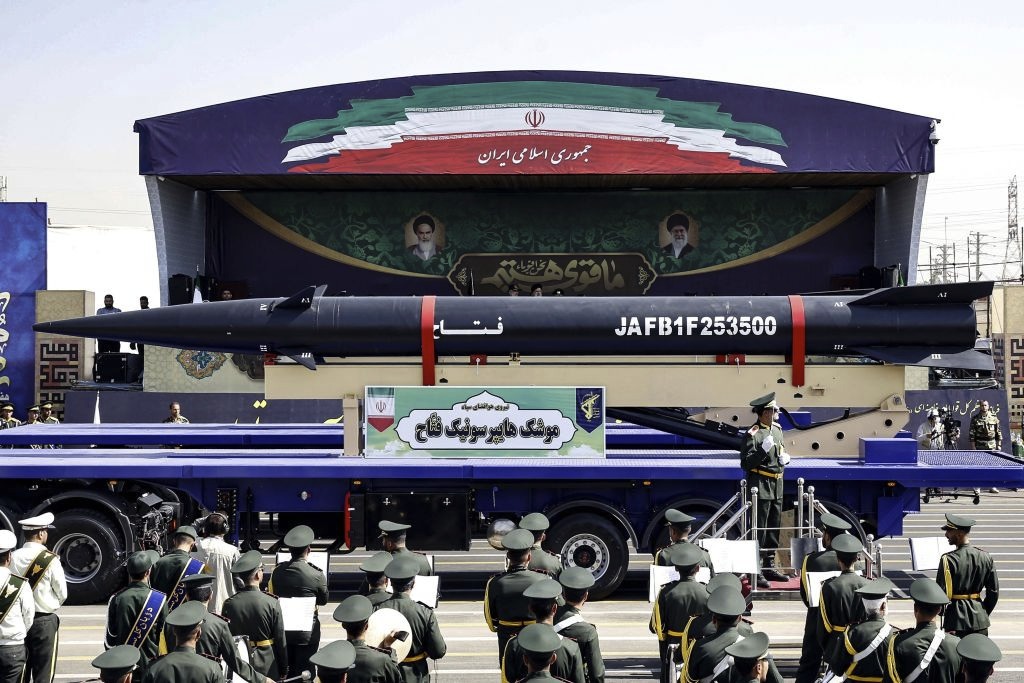Analysis/Backed by Iran, Yemen’s Houthi Fighters Flout Saudi Arabia’s Might
زيفي بارئيل من الهآررتس: المقاتلون الحوثيون وبدعم من إيران يهزؤون من قوة المملكة العربية السعودية في اليمن
Zvi Bar’el/Haaretz/August 03/18
The Yemeni theater has long since turned into a war of prestige, in which the two regional powers, Saudi Arabia and Iran, are trying to reap a political victory for themselves at the Yemenis’ expense
Tales of defeat have no place on the website of Almasirah television, the leading media outlet of the Houthi rebels in Yemen.
“Our forces fired missiles at a convoy of the invaders and mercenaries,” one report said. “Our forces’ missiles hit and destroyed the mercenaries’ tank. … In a single day, the army” – the Houthi one, of course – “destroyed 21 armored vehicles and four tanks belonging to the invaders.” The article ended with the Houthi slogan: “God is great, death to America, death to Israel, a curse on the Jews, victory to Islam.”
There was virtually no mention of the Arab coalition’s attacks on the Houthis or the killed and wounded Houthi fighters. When a station proudly titles itself “The Fighting Media,” its goal is to raise morale, not tell the whole story.
Almasirah is just one of some 25 Houthi-run media outlets, which have helped the Houthis recruit tens of thousands of fighters. Unofficial estimates say they now have more than 120,000 men under arms, up from just 3,000 to 7,000 three and a half years ago.
The civil war in Yemen is virtually nonexistent in the Western media, despite its enormous price – more than 10,000 people killed, half of them civilians; some 50,000 children dead of hunger or cholera; millions of displaced people, and hundreds of thousands suffering from malnutrition. Even Yemen’s strategic location on the Red Sea and the Bab al-Mandeb strait, and the fact that it has become a theater of international competition, with America, Saudi Arabia and the United Arab Emirates on one side and Iran on the other, haven’t managed to move it to the top of the global diplomatic and media agenda.
When Arab intervention in Yemen began in 2015, immediately after Saudi King Salman was crowned, it was expected to be a short, swift war. Saudi Arabia, armed with the best American weaponry, with pilots trained in America and America itself providing excellent intelligence, promised it could easily overcome the Houthi rebels and restore Yemen to the recognized government headed by Abed Rabbo Mansour Hadi, who had sought refuge in Saudi Arabia.
But following an other-worldly Saudi investment of about $5 billion a month – which paid for mercenaries from South America and Africa, among other things – and more than 100,000 sorties, the question now preoccupying Riyadh and its allies is how to get out of Yemen without this being perceived as an Iranian victory.
Because of the humanitarian disaster it has caused, the war recently managed to penetrate the walls of American apathy. Congress passed a law that would bar American planes from refueling Saudi and UAE warplanes unless Riyadh pledged to work for a diplomatic solution, reduce the harm to civilians and allow shipments of food and medicine to stricken areas.
But this law, which ostensibly restricts the use of American arms, does permit America to refuel Saudi planes engaged in other missions, like fighting Al-Qaida in Yemen, albeit only after Congress is given details about those missions. Thus, even this weak effort to wave a pale-yellow card at Riyadh and its partners won’t help the Yemeni population, because it won’t be hard to hide an attack on civilian population centers behind the pretext that Al-Qaida operatives are hiding among the civilians.
However, there are virtually no Saudi attacks on Al-Qaida bases in southern Yemen. Indeed, according to reports from Yemen, Saudi Arabia and the UAE are actually using Al-Qaida personnel to beef up tribal gangs fighting the Houthis with Saudi funding.
While President Barack Obama barred the sale of smart bombs to Riyadh in an effort to limit the civilian carnage, President Donald Trump has scrapped that decision. He has even encouraged Saudi Arabia and the UAE to keep fighting the Houthis, as part of the broader war against Iran.
But when Riyadh “invited” America to join the battle to capture the important port city of Hodeidah, Trump declined. He thereby sent a clear signal that the war in Yemen is a local or perhaps regional issue, but certainly not a strategic one that requires active American involvement. This echoes the lack of American policy in other Mideast countries where Iran has established or is establishing footholds, including Syria, Iraq, Lebanon and Afghanistan.
Yet looking beyond this American shrug and the disappointing military capabilities evinced by Saudi Arabia and the UAE despite their investment of tens of billions of dollars in military equipment, Yemen challenges the conventional wisdom that the war there is one against Iranian expansion.
There’s no dispute that Iran is arming the Houthis with relatively sophisticated weapons, including missiles that have hit Saudi Arabia, ships in the Red Sea and even the Abu Dhabi airport. Iran also apparently seeks to set up a military arm in Yemen similar to Hezbollah in Lebanon, and an unknown number of Hezbollah troops are actually fighting alongside the Houthis, training them in combat methods and ferrying arms to them.
In late June, Hezbollah leader Hassan Nasrallah even said he wished he were a soldier in the Houthi army fighting Yemen’s enemies on the country’s western front. In response, Yemen’s foreign minister sent a sharply worded letter to his Lebanese counterpart criticizing Hezbollah’s meddling in Yemen’s affairs.
Lebanon’s response said merely that it doesn’t always agree with the policies of all the country’s political factions. But even if it wanted to do something, Lebanon’s interim government obviously has no power to force Hezbollah to leave Yemen.
Nevertheless, the Houthis’ military alliance with Iran isn’t necessarily ideological or even strategic. The claim that it is a brotherhood of Shi’ites ignores the fact that the Houthis belong to the Zaidi sect, which is far from Iranian Shi’ite orthodoxy. The principles of the Zaidi religion actually closely resemble those of Sunni Islam, and Shi’ites in Yemen and elsewhere often view the Zaidis as a deviant sect.
Shi’ites constitute about 35 percent of Yemen’s population, and the Houthis are the biggest and most important Zaidi group. But even the Zaidi minority isn’t all cut from the same cloth.
One example is the bitter rivalry between two tribal confederations, the Hashid and the Bakil. Both claim descent from the same patriarch and both adopted the Zaidi faith, but they went in different political directions. While the Hashid – one of whose members is Ali Abdullah Saleh, the former Yemeni president ousted in the Arab Spring revolution and killed by the Houthis last December – supported the government, the Bakil joined the Houthis in fighting against the government.
Thus the view that the Houthi-Iranian connection rests on Shi’ite solidarity cannot explain the rivalry between these Zaidi tribes, which are fighting on opposite sides of Yemen’s civil war.
Moreover, the Houthis themselves, despite the aid they get from Iran, have no desire to create an Iranian-style republic in Yemen, with a supreme political leader who is also the supreme religious leader. Yemen is a bitterly divided tribal country. Thus to establish a stable government, it must create tribal and religious coalitions that unite southern tribes with northern ones and Sunnis with Shi’ites, and it must divvy up government budgets and jobs not solely on the basis of the election results, but primarily on the basis of tribal power.
Because tribalism is the dominant force that dictates political outcomes in Yemen – in contrast to the very different political and religious systems in Iraq and Lebanon – the most Iran can hope for is to maintain its ties to the Houthis. And those ties will depend on the aid Iran gives them, which the Houthis could also get from Arab states or America.
It’s also worth noting that while the Houthis originally took up arms to fight their discriminatory treatment by the central government; more than a decade passed before Iran decided to help. Moreover, Iran advised them to avoid an all-out war, and now, it’s working to end the war.
But the Yemeni theater has long since turned into a war of prestige, in which the two regional powers, Saudi Arabia and Iran, are trying to reap a political victory for themselves at the Yemenis’ expense. Efforts to solve the crisis by the United Nations, European Union and certain Arab states, including Kuwait and Oman, have repeatedly failed, crashing on the shoals of the conditions set by Riyadh and Abu Dhabi. They have adopted the Hadi government even though neither he nor his government is actually functioning. The very phrase “the recognized government” is meaningless, and the Arab coalition’s partial victories haven’t produced any major change in the balance of power.
The U.S. administration could play a decisive role in ending the war if it pressured Saudi Arabia and the UAE into serious negotiations with the Houthis. But when Washington is weighing the chance of distancing Iran from the Red Sea against the continued slaughter without victory, and pressure on an ally against the fear of being viewed as lending support to Iranian loyalists, it seems unlikely that it will lift a finger.






















